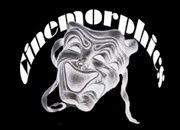Friday, September 18, 2015
The Mask of Persona
The mask of persona...what's inside?
The image comes from here...
http://www.thesecretofthegoldenflower.com/summary.html
Saturday, September 05, 2015
Alchemical Conjuration Tech

I have been asked on numerous occasions (I first posted this several years ago and am re-posting it now because of new questions) if Cinemorphics is a magical system. One of the early names I considered using for the approach and techniques for looking at and handling reality that became Cinemorphics was Alchemical Conjuration Tech (Training, Technique, Theory, Tao, etc.), so I guess I was looking at what I was putting together as a magical system all along. As these ideas developed, in my mind, what evolved was more of a post modern therapy model (sometimes compared to NLP) or a role playing reality manipulation “game” like Second Life…only occurring in “ordinary” reality rather than cyberspace. But the magical system take on Cinemorphics …from the POV of Chaos Magick especially… seems as appropriate as these.
What Cinemorphics technology DOES when someone re-writes, re-acts, re-directs, re-produces one’s persona…when someone realizes the fictitious and malleable nature of the “self”…creates and thoroughly inhabits a new “self” and all that goes with it…including a new belief system…IS…at the same time…call forth a new reality…a new world…in which to live. It has long been realized…in the case, say, of manifesting one’s desires…that whatever new is manifested into one’s reality changes the entirety of that reality. For example, addicts who quit realize this…along with their families…and the “new world” of the person minus the alcohol or drugs is oftentimes not what the ex-addict’s loved ones expected or wanted. One change is accompanied by many others. So Cinemorphics…Alchemical Conjuration Tech (the “real” A.C.T. as in Method acting) can “bend” reality to the will of the practitioner by evoking a new fictitious character (entity?) which the practitioner then inhabits (or is possessed by?). I have also used shape shifting and other metaphors for this process of transformation in the basic writings about Cinemorphics.

PHILOSOPHER'S STONE/HOODOO HEALING STICK
As is pointed out in these writings, though, this is not the whole story. Effectively exchanging one fiction for another is not what Cinemorphics…or Alchemical Conjuration Tech…is, finally, all about. If one realizes that one’s persona, and indeed one’s entire worldview, is a fiction, an illusion…fun to play with maybe, but still an illusion…then one can…maybe…realize who (what?) one really is. In this sense, this “system” is like Taoist alchemy…The Secret of the Golden Flower…which was why I originally thought of using alchemy as part of the name to begin with.

TAO
Wednesday, July 29, 2015
Tarot-icons
Look at Tarot card
layouts (also I Ching hexagrams, cast bones, etc.) as icons on the “desktop”
(user interface with “reality”) of the person being read…a synchronicity…an
array of symbols that “are” the person at a given moment in time…another way of
telling their story. This chance set of icons can be re-arranged, resulting in
changes in the person in the “real” world.
This kind of
manipulation is a sort of Cinemorphic (re-write yourSELF) manipulation…an
alternate reality game. i.e. don’t just use divination methods to “tell a
fortune” or read someone “as they are” but also manipulate the oracle to change
them.
Look at the Tarot as a
semiotic web (like an organism with an intelligence?) which we can interact
with…have a conversation with…talk to….cajole.
Labels:
Alejandro Jodorowsky,
Camelia Elias,
Enrique Enriquez,
magick,
tarology
Wednesday, July 08, 2015
The Ontology of Semiosis
A Conscious Agent (see Hoffman, 2008, Conscious Realism and the Mind Body Problem) can be a symbol (and part of the semiotic web) but not all symbols are Conscious Agents. Patrick Dunn’s semiotic web is roughly analogous to Donald Hoffman’s user interface, in which symbols = icons. An individual Conscious Agent’s semiotic web (user interface) includes other Conscious Agents as well other types of symbols (icons). Reality consists of inter-related and interacting semiotic webs, each with a Conscious Agent at its center. The Conscious Agent at the center is the Persona of Cinemorphics. The symbols in the semiotic web are the persona’s “inventory” of characteristics. Cinemorphic change (deleting and adding characteristics) is the same as changing the symbols in the semiotic web to bring about reality shifts. “Symbol changing” can also be brought about by creating NEW metaphors…i.e. “You” ARE a persona/ego/self becomes “You” ARE a character that can be changed around (like in a script). Re-framing…re-metaphorizing is the “reality handling”/manipulation that results in
Monday, July 06, 2015
At Play In The Semiosphere
I will be discussing Patrick Dunn's approach to reality handling and manipulation within the context of Cinemorphic self shifting in future posts. Interesting parallels and implications...
“Think of a huge web stretching across the black emptiness of space. In each nexus of lines rests a symbol connecting to an infinite number of other symbols. It is important to grasp this concept, because symbols are the underlying girders of the universe.
I call this complex of recursive symbols ‘the semiotic web.’ When seeking meaning, the mind says ‘I can place any idea in my semiotic web, which I've built up from all the symbols of our culture, and have it make sense to me.’
I believe the semiotic web is the substance of ultimate reality. More than just an abstraction to explain the way the human mind works, I think it is the abstraction to explain how Mind works. Mind is not separate from reality, nor is reality separate from the semiotic spaces it inhabits.
Manipulating symbol systems manipulates the semiotic web, and therefore manipulates reality.”
Patrick Dunn. Postmodern Magic: The Art of Magic in the Information Age http://www.amazon.com/Postmodern-Magic-The-Art-Information/dp/0738706639
Friday, May 22, 2015
How Artificial Superintelligence Will Give Birth To Itself
"How Artificial Superintelligence Will Give Birth To Itself" by George Dvorsky is a particularly interesting window on the world of AI research from the POV of Cinemorphics...
"There's a saying among futurists that a human-equivalent artificial intelligence will be our last invention. After that, AIs will be capable of designing virtually anything on their own — including themselves. Here's how a recursively self-improving AI could transform itself into a superintelligent machine."
For the entire article click HERE.
Ex Machina, AI and Cinemorphics
Ex Machina's AI, Ava, seems to have developed, after her original inception, a very interesting form of intelligence...the ability to choose and "absorb" new abilities for herself. An interesting analysis of the film may be found HERE...
/
Also...COMING SOON...Cinemorphics as an AI protocol...enabling persona creation in robots!
Tuesday, May 12, 2015
American Eyeball
A new Benny Pristine mystery! The notorious San Francisco detective reappears after a twenty year disappearance to find his best friend murdered, a psychic spy still wanting to take him to bed, the fate of the world threatened by incompetent aliens and more!
American Eyeball - Trailer from Charles Webb on Vimeo.
Read the Benny Pristine novella SATORI TANGO!
Tuesday, April 21, 2015
Monday, February 23, 2015
Sunday, February 08, 2015
Ruby Wax on Neuroplasticity: "You're the Architect of Your Own Brain"
Ruby Wax put her comedy career on hold a few years ago in order to research mental illness and mindfulness-based cognitive therapy at Oxford. It's there that she first encountered neuroplasticity: the ability to rewire your brain just by changing the way you think. Wax, who sports a Master's in Mindfulness-based Cognitive Behavioural Therapy, now travels the world promoting mental health awareness and stigmatization. Her new book is titled "Sane New World."
To play video please visit: http://bigthink.com/videos/ruby-wax-on-neuroplasticity
Friday, January 30, 2015
Saturday, January 24, 2015
Sunday, January 11, 2015
Should Schools Teach Personality!
Self-control, curiosity, “grit” — these qualities may seem more personal than academic, but at some schools, they’re now part of the regular curriculum. Some researchers say personality could be even more important than intelligence when it comes to students’ success in school. But critics worry that the increasing focus on qualities like grit will distract policy makers from problems with schools.
For the entire article click HERE .
Subscribe to:
Posts (Atom)










